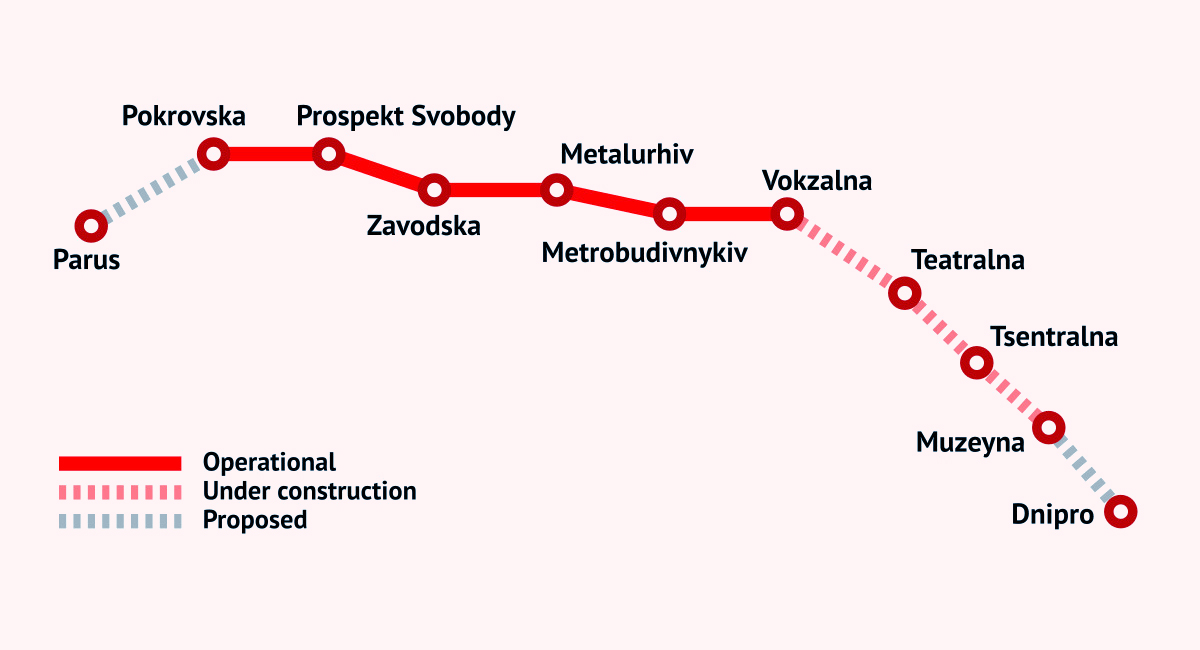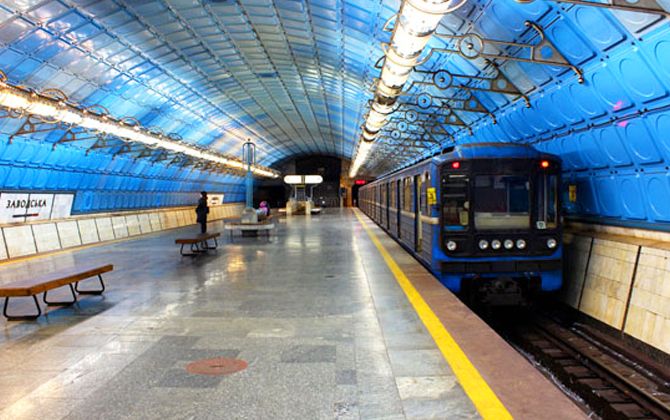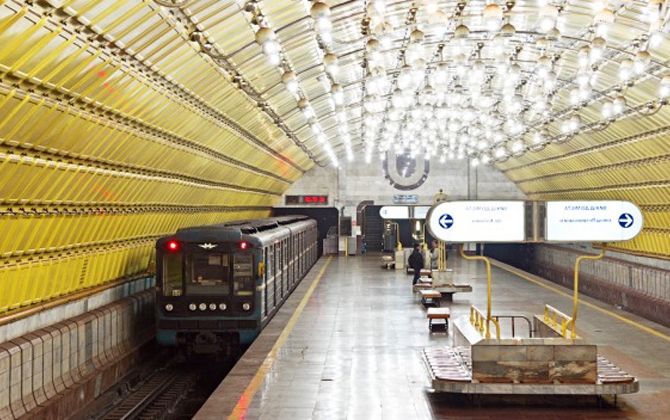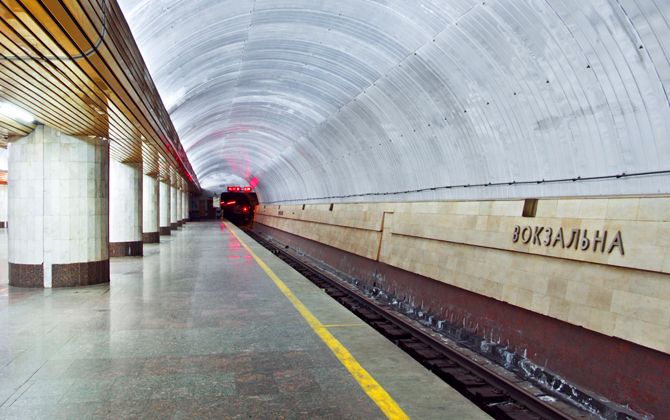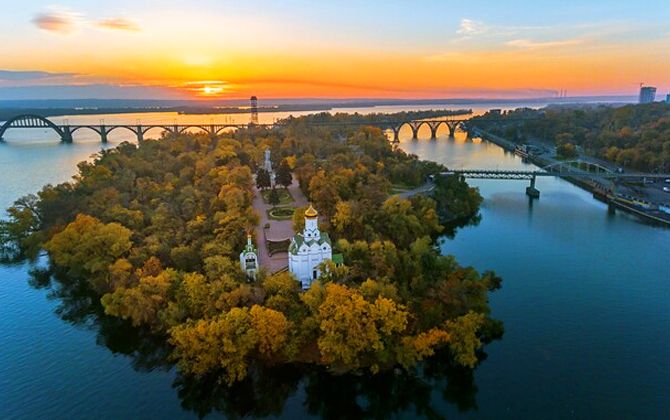Dnipro Metro is a rapid transit system in Dnipro (formerly Dnipropetrovsk), southeastern Ukraine. It has a single line — the Tsentralno–Zavodska Line — running east to west across the city. The line is 7.8 km (4.8 mi) long and includes 6 stations.
The system opened on December 29, 1995, shortly after the collapse of the USSR. Today, it carries about 40,000 passengers daily.
All stations were built with long platforms, around 102–105 m (335–344 ft), designed for 5-car trains. However, due to reduced demand, trains currently operate with only 3 cars.
Dnipro Metro Map
A 2025 route map of the Dnipro Metro is available online in PDF and image formats. It shows the single Tsentralno–Zavodska Line, stretching from the western terminus at Pokrovska to the eastern terminus at Vokzalna. The line runs for 7.8 km (4.8 mi) and connects key neighborhoods in the city center.
Planned extensions appear on future versions of the map, but as of 2025 the line still operates with six active stations.
Map of Dnipro Metro showing different lines. Click on the map to enlarge it or download the Dnipro Metro map in PDF format.
Lines and Stations
The Dnipro Metro operates one line — the Tsentralno–Zavodska Line.
Vokzalna — Eastern terminus under Vokzalna Plaza, next to Dnipro Central Railway Station. Opened on December 29, 1995. Multiple entrances connect to the square and nearby transport hubs.
Metrobudivnykiv — Opened on December 29, 1995. Its name means “Metro Builders,” honoring the workers who built the system. Three exits lead to Serhiy Nigoyan Avenue and Ivan Mazepa Avenue.
Metalurhiv — Opened on December 29, 1995. Named after the city’s steelworkers. Serves industrial neighborhoods, with exits to Serhiy Nigoyan Avenue near the Organ Music Centre.
Zavodska — Opened on December 29, 1995. Its name comes from the nearby factory district (“zavod” means factory). Exits lead to Mayakovskoho Street and nearby industrial areas.
Prospekt Svobody — Located on Novokodatska Square in the Freedom Avenue district. Opened in 1995. Surrounded by shops and local government buildings.
Pokrovska — Western terminus, opened in 1995. Located between Yuria Kondratuka and Velyka Diivska streets, serving the Chervonyi Kamin and Pokrovsky neighborhoods. Handles end-of-line turnarounds and has exits to nearby residential blocks.
Each station features distinct Soviet-era architecture. Some include marble columns and chandeliers in the style of the 1970s–80s. All original stations were built as deep-level structures, about 70 m (230 ft) underground, with long escalators at each entrance.
Operating Hours
The Dnipro Metro runs daily from early morning until late evening. First trains leave Pokrovska around 05:30–05:35, and the last trains finish service by 23:00. Hours are the same every day of the week.
Service is frequent: during weekday peak hours trains run every 7 minutes. Off-peak and weekends see headways of about 10–12 minutes, though at very low-demand times intervals may stretch to around 20 minutes. A full trip across the line takes 12–15 minutes.
Fare Structure
The system uses a flat fare — one price for any single ride. As of January 2025, the adult fare is 10 UAH (about $0.27). Students, pensioners, and other eligible riders pay 5 UAH (about $0.14). Children under 6 travel free. Fares are set by city ordinance and may change; the 10 UAH price reflects a recent increase in early 2025.
| Fare Type | Price (UAH) | Price (USD) |
|---|---|---|
| Single adult ticket | 10 | ~$0.27 |
| Student / pensioner (50% off) | 5 | ~$0.14 |
| Child (under 6) | Free | — |
Tickets or tokens are sold at station booths and vending machines. Payment is accepted in cash and by contactless methods. Monthly and combined passes for metro, trams, and trolleybuses are also offered, but those fall under separate municipal programs.
Connectivity
Although small, the metro links well with other transport modes: trams, trolleybuses, and city buses. Connections at each station are:
- Vokzalna: Trams 1, 11, 14, and 15; trolleybus line B. Many city buses also stop here, including Bus 109 to the airport and Bus 152 to western districts.
- Metrobudivnykiv: Tram lines 5 and 14; trolleybus 4.
- Metalurhiv: Tram lines 5 and 14; trolleybus 4.
- Zavodska: Tram lines 5 and 14.
- Prospekt Svobody: Tram 18.
- Pokrovska: No direct tram or trolleybus service. Local buses serve nearby neighborhoods.
Each station allows quick transfer to Dnipro’s tram and trolley networks. From the metro, passengers can reach nearly any part of the city by tram or bus. Detailed bus-route information is published by the city transport authority.
Airport Connection
Dnipro International Airport (DNK) has no direct metro link, but it is reachable from Vokzalna station. From the square outside Vokzalna, Bus 109 (Stari Kodaky – Airport) runs to the terminal. The trip takes just over 1 hour with about 39 stops. Children and pass-holders use the same tickets.
Since Bus 109 is a regular city route, expect a long local ride rather than an express service. Taxis and private shuttles are also available at Vokzalna.
Future Expansions
Expansion plans have been in place for decades. In the late 2010s, work restarted on a 3-station western extension from Vokzalna into the city center. The new stations — Teatralna (near the Opera and Drama Theatre), Tsentralna, and Muzeina (near the History Museum) — are under construction. When complete, the extension will add about 4 km (2.5 mi), bringing the line to 11.8 km (7.3 mi) and 9 stations in total.
Original estimates targeted an opening around 2025, but delays caused by funding issues and the 2022 war have pushed the timeline back. As of now, the extension remains unfinished, and passengers must rely on the existing six stations.
Interesting Facts
- Deep shelters — All stations lie about 70 m (230 ft) underground, built as Cold War bomb shelters. Escalators here are among the longest in Ukraine.
- Changing trains — In the 1990s, trains ran with 5 cars. Today only 3 cars are used due to lower demand.
- Unique architecture — Each station has its own design. Pokrovska features white marble arches, while Vokzalna has vaulted ceilings with chandeliers.
- Metro Museum — A small museum on Kurchatov Street (near Pokrovska) displays photos, models, and documents. Open on selected weekdays.
- Ridership drop — The metro carried about 18 million riders in 1995. By 2013 this fell to 7 million. Today it averages 10–15 million per year (~40,000 daily).
- Only one line — Dnipro Metro is Ukraine’s smallest system. It is one of only four metros in the country (along with Kyiv, Kharkiv, and Odesa).
History
Planning for the Dnipro Metro began in the late 1970s under the Soviet Union. Feasibility studies started in 1979, once the city’s population was projected to pass one million. Construction officially began on February 20, 1981. The system was meant to open in 1991, but the collapse of the USSR halted funding. The first six stations finally opened on December 29, 1995, making Dnipro (then Dnipropetrovsk) the third Ukrainian city with a metro after Kyiv and Kharkiv.
In the 1990s, trains ran with 5-car sets as originally planned. Ridership was about 18 million in 1995 but dropped to around 7 million by 2013. The metro has always been municipally owned, now operated by the Dnipro Metro company, and remains a key part of the city’s transport system.
The Construction of Dnipro Metro
Building the system was difficult. All six original stations are deep-level, around 70 m (230 ft) underground, designed to double as nuclear shelters during the Cold War. Construction required tunneling and shaft sinking through hard rock beneath the city. Soviet funds dried up in 1991, but Ukraine completed the project by 1995.
Platforms were built 102–105 m (335–344 ft) long to handle 5-car trains, though today trains run with only 3 cars. The metro was one of the last Soviet-style metro projects, showcasing typical 1980s architecture and decoration. Since opening, the system has received only basic maintenance, with no major extensions until recent years.
Rules
- No alcohol, intoxicated passengers, or offensive clothing.
- Do not block stairs, doors, or platforms.
- No running on escalators or platforms.
- No littering or entering the tracks.
- No weapons, dangerous items, oversized or smelly luggage.
- No smoking, begging, or unauthorized trade.
- Photography and video require official permission.
Tourist Attractions
The Dnipro Metro provides access to many of the city’s landmarks. Notable attractions include:
- Taras Shevchenko Park & Monastyrsky Island — A large riverside park with a zoo, rides, and a summer beach on the island. Served by Pokrovska station, with Bus 141 connecting to the park and zoo area.
- Dmytro Yavornytsky National Historical Museum — Located in a neoclassical building on Yavornytsky Avenue, the museum showcases Dnipro’s history from ancient Scythians to WWII. Accessible from Vokzalna station by foot or tram 101A (about 100 m away).
- Menorah Center — Opened in 2012, this is the largest Jewish cultural center in Europe, including a synagogue and Holocaust museum. From Vokzalna, visitors can walk or take a short taxi or tram ride.
- Transfiguration Cathedral — A 19th-century Orthodox cathedral on the city’s main avenue. The interior, once destroyed by the Soviets, has been restored. Reachable by tram or bus from the metro line.
- Dnipro Quay (Embankment) — A riverside promenade stretching about 23 km (14 mi). Popular for walking and leisure, it begins near the city center and can be reached by tram or bus from Vokzalna or Pokrovska.
- Other attractions — Yavornytsky Avenue with monuments, shops, and cafés; War and Military museums including a WWII diorama; Lazar Hrebenyuk (Globa) Park; and cultural venues like the Opera & Ballet Theatre on Teatralna Square. University buildings are located between Prospekt Svobody and the planned Teatralna station.
Most attractions are accessible with a short tram or bus ride from metro stations. For more details, consult city tourist guides.
